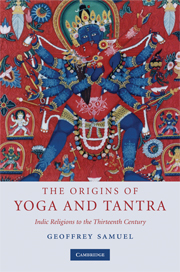Book contents
- Frontmatter
- Contents
- List of figures
- Preface
- 1 Introduction
- 2 Stories and sources
- PART ONE MEDITATION AND YOGA
- 3 The Second Urbanisation of South Asia
- 4 Two worlds and their interactions
- 5 Religion in the early states
- 6 The origins of the Buddhist and Jaina orders
- 7 The Brahmanical alternative
- 8 Interlude: Asceticism and celibacy in Indic religions
- PART TWO TANTRA
- References
- Index
4 - Two worlds and their interactions
Published online by Cambridge University Press: 05 June 2012
- Frontmatter
- Contents
- List of figures
- Preface
- 1 Introduction
- 2 Stories and sources
- PART ONE MEDITATION AND YOGA
- 3 The Second Urbanisation of South Asia
- 4 Two worlds and their interactions
- 5 Religion in the early states
- 6 The origins of the Buddhist and Jaina orders
- 7 The Brahmanical alternative
- 8 Interlude: Asceticism and celibacy in Indic religions
- PART TWO TANTRA
- References
- Index
Summary
Chapter 3 introduced the wider context within which early developments in Indian religion and society were taking place at around 500 to 400 BCE. In it I mentioned Tom Hopkins' suggestion that Northern India at that time contained two contrasting and in some ways opposed worlds, the Brahmanical and Vedic-derived world associated with the Kuru and Pañcāla kingdoms, and the non-Vedic world of the Central Ganges and northern Deccan (Fig. 4.1).
While these worlds were in many ways opposed, it is important to remember that they also had some important things in common. These included a shared Indo-Aryan language. They also shared at least some other elements of Indo-Aryan cultural heritage, including the presence of Brahmins and of the basic social divisions of Indo-Aryan society, as well as the worship of some Indo-Aryan deities such as Indra. This is not an ‘Aryan invasion’ model; I assume that populations in both regions were mixtures of earlier Indo-Aryan and non-Indo-Aryan speaking populations. The distinctiveness of the Kuru-Pañcāla region was cultural, not racial.
In addition, we should be aware that the two worlds were not in any way sealed from each other; the early Upaniṣads describe Kuru-Pañcāla Brahmins travelling to Kāśi and Mithilā, and Buddhism and Jainism rapidly made inroads into areas like Śūrasena with close links to the Kuru-Pañcāla region.
- Type
- Chapter
- Information
- The Origins of Yoga and TantraIndic Religions to the Thirteenth Century, pp. 61 - 93Publisher: Cambridge University PressPrint publication year: 2008



